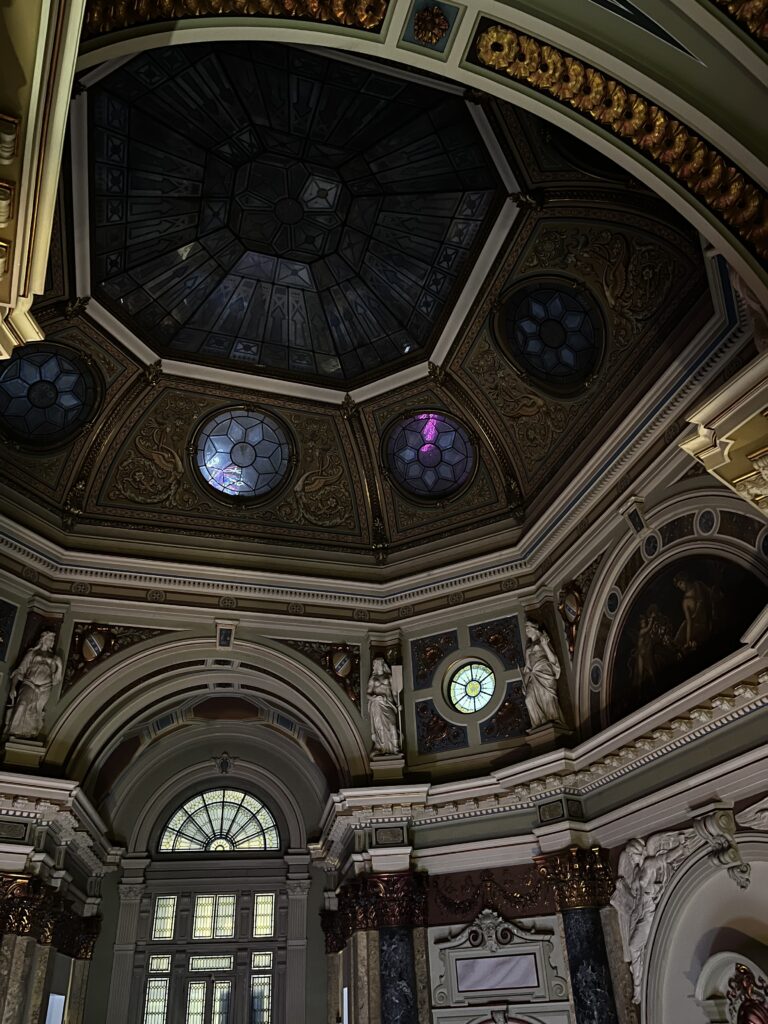This summer I went to a temporary art exhibition in my home city, Bucharest. The building itself, an old palace in the old town, is an architectural jewel, with intricate details and a myriad of materials. It was my first time going inside and I was left in awe. The main room, the dome, is covered in a veil of darkness and mystery, with just a few rays of light coming from the small bulls’ eye windows. I find the play between light and darkness almost surreal and dream like. Light is a quintessential tool for any interior, as it successfully draws attention to certain key elements.
Upon my work in preparation to becoming an interior designer/architect, I have discovered a myriad of ways in which light can dramatically make a difference. For instance, adequate lighting is essential for visibility and functionality in any space. Proper illumination allows people to perform tasks comfortably and safely, whether it’s reading, cooking, working, or any other activity. Secondly, light has a significant impact on the visual appeal of a space. The way light interacts with colors, textures, and shapes can enhance or diminish the overall aesthetic of a room. Thoughtfully designed lighting can highlight architectural features, artwork, or specific design elements, contributing to the overall ambiance. Thirdly, lighting can influence the mood and atmosphere of a room. Different types of lighting, such as warm or cool tones, can create varying emotional responses. For example, warm lighting may evoke a cozy and intimate atmosphere, while cool lighting can create a more lively and energetic feel. Furthermore, light also affects how we perceive the size and shape of a room. Well-planned lighting can visually expand or contract spaces, making them feel larger, cozier, or more open based on the design goals. Lastly, natural light, in particular, has been linked to improved well-being and productivity. Incorporating natural light into interior design can positively impact occupants by regulating circadian rhythms, improving mood, and reducing eyestrain.
Whilst it is clear that lighting is vital for the spaces we inhabit, it is important to highlight that most luminaires and light fixtures are energy consuming and not eco-friendly. Thus, the world of interior design and lighting has been recently opting for alternatives, such as LED lights, which consume less energy, or, many firms have come up with innovative luminaires. The brand Flos, is a great example of being able to focus on both aesthetics and sustainability at the same time. For example, their Super Line Pro luminaire, a suspended bar for working spaces, has been provided with a remote driver that can be easily replaced or upgraded to a dimmable system. Thus, they take the environment into consideration with every product they design.
Sources: fig1- www.iop.org- difference between LED ad traditional light bulbs in terms of Watts
fig2: photo taken by Daria (me), September 2023
Licht, U. Brand. & Wiegelmann, Andrea. (2006) Lighting design : principles, implementation, case studies / Ulrike Brandi Licht ; [authors: Christina Augustesen [and others] ; editor: Andrea Wiegelmann]. Basel: Birkhäuser.
Smith, F. Kellogg. et al. (1986) Bringing interiors to light : the principles and practices of lighting design / Fran Kellogg Smith, Fred J. Bertolone ; edited by Diane Casella Hines. New York: Whitney Library of Design.





